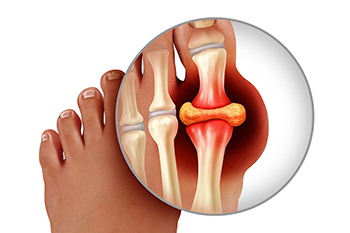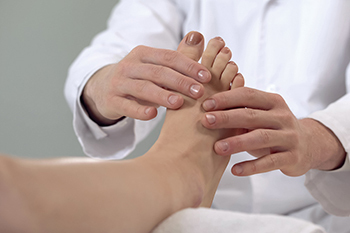

The pain from the foot condition known as gout is often worse during the night. Patients are often awakened by swollen joints in the big toe that can become red and inflamed. This extremely painful ailment, a type of arthritis, can cause an inability to walk, and crawling up the steps is not uncommon in severe cases. Gout can happen as a result of genetic reasons, or from eating foods that have high levels of purines. Foods in this category include shellfish, red meat, and drinks that are made with large amounts of sugar. These types of foods produce excess uric acid, which forms into crystals that can lodge in the joints of the big toe. There are methods that can be implemented that may help to diminish some of the pain of gout. Among them are drinking plenty of water, frequently elevating the affected foot, and eliminating the foods that can cause this condition. Gout can be recurring, so it is strongly suggested that you are under the care of a podiatrist who can help you to manage this ailment and provide you with proper relief tactics.
Gout is a painful condition that can be treated. If you are seeking treatment, contact Dr. Stephan J. LaPointe from Georgia Foot & Ankle Specialists . Our doctor will treat your foot and ankle needs.
What Is Gout?
Gout is a form of arthritis that is characterized by sudden, severe attacks of pain, redness, and tenderness in the joints. The condition usually affects the joint at the base of the big toe. A gout attack can occur at any random time, such as the middle of the night while you are asleep.
Symptoms
Risk Factors
Prior to visiting your podiatrist to receive treatment for gout, there are a few things you should do beforehand. If you have gout you should write down your symptoms--including when they started and how often you experience them, important medical information you may have, and any questions you may have. Writing down these three things will help your podiatrist in assessing your specific situation so that he or she may provide the best route of treatment for you.
If you have any questions, please feel free to contact our office located in Rome, GA . We offer the newest diagnostic and treatment technologies for all your foot care needs.

There are some people who refer to bunions as a bone disorder. This foot condition is the result of a foot structure abnormality, and can be caused by genetic factors. Additionally, patients who choose to wear shoes that do not have adequate room for the toes to move freely in may notice a bunion is developing. It is defined as a bony protrusion on the side of the big toe, and in severe cases, may be large enough to shift the other toes toward each other. There may be existing medical conditions that may lead to getting a bunion. These can include having a low arch, rheumatoid arthritis, or possibly from having endured a foot injury. Common symptoms that affect many people with bunions can consist of redness, numbness, and there may be a burning sensation in the affected joint. Mild relief may come from wearing shoes that are larger which can accommodate the protrusion, and it may help to place a protective covering over the bunion. If you have a bunion, it is advised that you are under the care of a podiatrist who can offer you effective treatment options.
If you are suffering from bunions, contact Dr. Stephan J. LaPointe of Georgia Foot & Ankle Specialists . Our doctor can provide the care you need to keep you pain-free and on your feet.
What Is a Bunion?
A bunion is formed of swollen tissue or an enlargement of boney growth, usually located at the base joint of the toe that connects to the foot. The swelling occurs due to the bones in the big toe shifting inward, which impacts the other toes of the foot. This causes the area around the base of the big toe to become inflamed and painful.
Why Do Bunions Form?
Genetics – Susceptibility to bunions are often hereditary
Stress on the feet – Poorly fitted and uncomfortable footwear that places stress on feet, such as heels, can worsen existing bunions
How Are Bunions Diagnosed?
Doctors often perform two tests – blood tests and x-rays – when trying to diagnose bunions, especially in the early stages of development. Blood tests help determine if the foot pain is being caused by something else, such as arthritis, while x-rays provide a clear picture of your bone structure to your doctor.
How Are Bunions Treated?
If you have any questions, please feel free to contact our office located in Rome, GA . We offer the newest diagnostic and treatment technologies for all your foot care needs.

Foot or ankle surgery can be recommended by a podiatrist to relieve pain, correct a foot deformity, or restore function to a foot or ankle. It is often a last resort, after more conservative treatments are prescribed. Such surgery is usually elective and takes place in a podiatrist’s office, in a hospital, or a surgery center. Whether or not surgery is suggested depends on one’s age, medical history, and insurance coverage. Once surgery is done, the patient must follow instructions for the foot or ankle to heal properly and without complications. Foot surgeries can include toenail removal, and arthroscopic foot or ankle surgery. This is a type of endoscopy that allows a doctor to investigate an area of the body without cutting it open. Additional types of surgeries can consist of plantar fascia release, and ankle fusion or replacement. If you have foot or ankle problems and pain interferes with your daily life, see a podiatrist for proper diagnosis and treatment. Surgery may be appropriate if other treatments are ineffective.
Foot surgery is sometimes necessary to treat a foot ailment. To learn more, contact Dr. Stephan J. LaPointe of Georgia Foot & Ankle Specialists . Our doctor will assist you with all of your foot and ankle needs.
When Is Surgery Necessary?
Foot and ankle surgery is generally reserved for cases in which less invasive, conservative procedures have failed to alleviate the problem. Some of the cases in which surgery may be necessary include:
What Types of Surgery Are There?
The type of surgery you receive will depend on the nature of the problem you have. Some of the possible surgeries include:
Benefits of Surgery
Although surgery is usually a last resort, it can provide more complete pain relief compared to non-surgical methods and may allow you to finally resume full activity.
Surgical techniques have also become increasingly sophisticated. Techniques like endoscopic surgery allow for smaller incisions and faster recovery times.
If you have any questions please feel free to contact our office located in Rome, GA . We offer the newest diagnostic and treatment technologies for all your foot and ankle needs.

There are many causes of heel pain. Heel pain is often caused by plantar fasciitis, which is an inflammation of the connective tissue that spans the sole of the foot—from the heel bone through the arch up into the forefoot. Heel spurs, which are calcium deposits that form on the heel bone in response to repeated trauma, can sometimes cause heel pain as well. Oftentimes, these two conditions occur at the same time. People may be more at risk of developing heel pain if they are overweight, which puts undue stress and tension on the plantar fascia. Overusing the plantar fascia may also contribute to plantar fasciitis, as well as having tight calf muscles or wearing improper footwear that does not offer adequate support. If you have any heel pain, see a podiatrist who can diagnose and help to remedy this condition.
Many people suffer from bouts of heel pain. For more information, contact Dr. Stephan J. LaPointe of Georgia Foot & Ankle Specialists . Our doctor can provide the care you need to keep you pain-free and on your feet.
Causes of Heel Pain
Heel pain is often associated with plantar fasciitis. The plantar fascia is a band of tissues that extends along the bottom of the foot. A rip or tear in this ligament can cause inflammation of the tissue.
Achilles tendonitis is another cause of heel pain. Inflammation of the Achilles tendon will cause pain from fractures and muscle tearing. Lack of flexibility is also another symptom.
Heel spurs are another cause of pain. When the tissues of the plantar fascia undergo a great deal of stress, it can lead to ligament separation from the heel bone, causing heel spurs.
Why Might Heel Pain Occur?
Treatments
Heel pain should be treated as soon as possible for immediate results. Keeping your feet in a stress-free environment will help. If you suffer from Achilles tendonitis or plantar fasciitis, applying ice will reduce the swelling. Stretching before an exercise like running will help the muscles. Using all these tips will help make heel pain a condition of the past.
If you have any questions please contact our office located in Rome, GA . We offer the newest diagnostic and treatment technologies for all your foot and ankle needs.